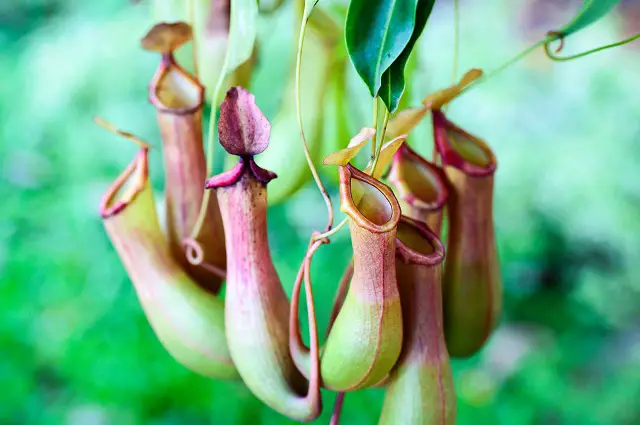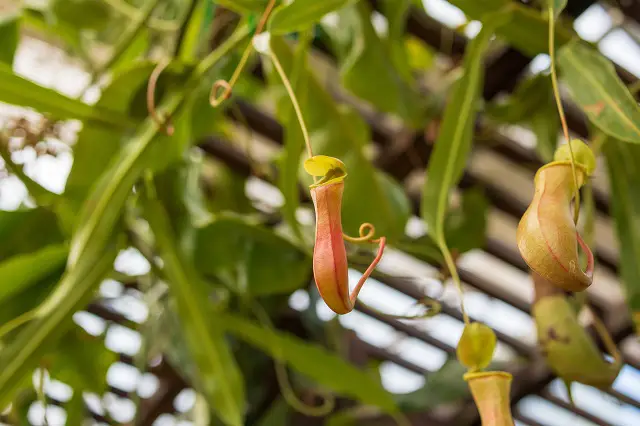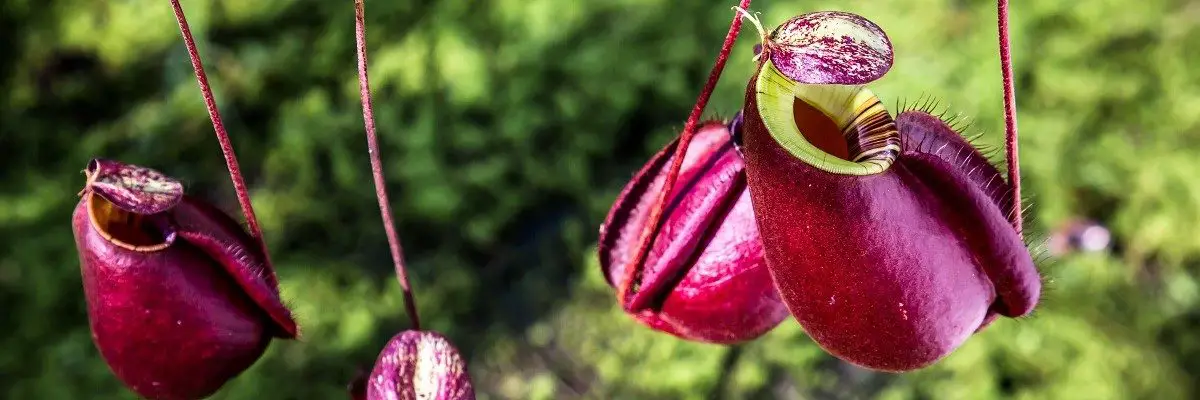The monkey Cup is also known as Monkey Jar, and pitcher plants but formally known as Nepenthes. The plant is one of a large family of tropical carnivorous plants indigenous to Southeast Asia, Southern China, the Philippines, Madagascar, and northern Australia.
The majority of the Nepenthes species live in tropical and hot, humid jungles; however, there are a few that can also be found in montane forests or highland regions. The reason for this is that those regions have considerably cooler temperatures.
There are many Nepenthes species, ranging in size from small miniatures such as Nepenthes ampullaria to majestic monstrosities such as Nepenthes rajah. It has been reported that it is one of the only plant species in this genus that has been found to catch and consume whole rats.
Why are they called Monkey Cups or Monkey Jars?
This trap is sometimes referred to as a monkey cup due to the fact that monkeys will frequently drink fluid out of the cup-like traps in the wild. This is due to the pitcher shape that its leaves form, allowing rainwater to gather in the bottom of the jars or cups.
How big do monkey Cups grow?
There are various types of tropical monkey jar plants, generally climbing plants or semi-shrubs. The majority of people grow these plants as hanging plants. This way, the unique leaves can be seen dangling from the plant. The stems can usually be found reaching up to 16 inches in length and are slow to grow.
A single species of carnivorous plant, Attenborough’s pitcher plant, is one of the largest in the world, reaching a height of up to 1.5 meters (4.9 feet). In addition to its pitchers, which measure 30 cm (11.8 inches) in diameter, the device can also capture and digest rodents and other small animals.

How does the monkey cup plant eat?
A monkey cup first lures the insects to its trap by secreting sweet nectar on specific spots on the trap. This then attracts the insects to investigate. Upon stepping onto the slippery upper rim of the monkey jar pitcher to try and consume the nectar, the insect will fall into the trap. After this, the insect will drown and be digested by the fluid in the monkey cups pitcher.
What does the monkey cup plant eat?
Monkey cups produce their food through photosynthesis, as do all other plants. As a result, they do not require capturing insects as a means of surviving. They only need to capture insects to extract key nutrients that will boost their growth. Here are some of the insects a Monkey Jar may eat.
| Mosquitos | Moth |
| Cockroaches | Spiders |
| Beetles | Ants |
| Butterfly | Cricket |
| Caterpillars | Flies |
| Gnats | Ladybugs |
How long do monkey jars live?
If you are talking about the pitcher themselves, then an individual pitcher can last between one and eight months, depending on the type. When pitchers go through a deterioration stage due to aging, the top portion of their pitches will usually turn brown first. They can remain in this half-withered state for several months. Even when brown, these leaves are still helpful to the plant and can be trimmed off once they are completely browned.
How do you prune a monkey jar?
First of all, if your Monkey Jar blooms, you need to prune off the flowers as soon as they begin to wilt, just like you would other plants.
There is no need to do anything more complicated when pruning this plant. By simply cutting off the stalk of the bloom at its base, you can remove the bloom from the stem.
If you notice that the leaves of your pitcher plant are yellow or brown, it means that that part of the plant is dying. You do not need to be a professional to trim a monkey jar to get rid of dead foliage. To remove the dead leaves, you simply cut them off at the point where they meet the plant’s stem.

How do you look after monkey jar plants?
If you are growing Monkey Jars indoors, you can water the soil as needed to prevent it from becoming soggy, but don’t do so at a regular rate. The Monkey Cup should be placed in a moderately bright setting and should be kept away from direct, intense sunlight. It is helpful to move the plant into lower light if the leaves turn yellow or the leaf edges look scorched or brown.
It is very important to remember that Monkey Jars are extremely sensitive to chemicals in tap water and will benefit greatly from distilled water or rainwater. It is generally recommended that indoor monkey cups be cared for at temperatures between 65 and 80 degrees Fahrenheit (18-27 degrees Celsius).


